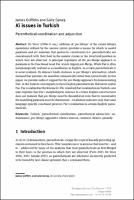Chapter Ki issues in Turkish
| dc.contributor.author | Griffiths, James | |
| dc.contributor.author | Güneş, Güliz | |
| dc.contributor.editor | Kluck, Marlies | |
| dc.contributor.editor | Ott, Dennis | |
| dc.contributor.editor | de Vries, Mark | |
| dc.date.accessioned | 2019-11-13 23:55 | |
| dc.date.accessioned | 2020-01-07 16:47:06 | |
| dc.date.accessioned | 2020-04-01T09:29:43Z | |
| dc.date.available | 2020-04-01T09:29:43Z | |
| dc.date.issued | 2014 | |
| dc.identifier | 1006327 | |
| dc.identifier | OCN: 1135854360 | en_US |
| dc.identifier.uri | http://library.oapen.org/handle/20.500.12657/23811 | |
| dc.description.abstract | De Vries’ (2006 et seq.) addition of ‘par-Merge’ to the extant Merger operations utilized by the narrow syntax provides a means by which to model parataxis and yet maintain that paratactic constituents (i.e. parentheticals) are concatenated with their host in the narrow syntax in the structural position in which they are observed. A principal ingredient of the par-Merge approach to parataxis is the functional head Par, which triggers par-Merge. While Par is often morphologically realized as a coordinator in English, in certain parentheticals itis never realized. Its absence lends credence to par-Merge’s alternatives, which demand that parataxis be modelled semantically rather than syntactically. In this paper, we provide indirect support for the par-Merge approach by demonstrating that, in the Turkish counterparts to those English parentheticals that never realize Par, Par is realized as the lexeme ki. If ki is indeed Par’s realization in Turkish, one may stipulate that Par’s morphological absence in certain English constructions does not indicate that par-Merge must be discarded or even that its universalityformodellingparataxismustbediminished–itsabsenceindicatesonlythatsomelanguage-specific constraint prevents Par’s realization in certain English parentheticals. | |
| dc.language | English | |
| dc.subject.classification | thema EDItEUR::C Language and Linguistics::CF Linguistics | en_US |
| dc.subject.classification | thema EDItEUR::C Language and Linguistics::CF Linguistics::CFA Philosophy of language | en_US |
| dc.subject.classification | thema EDItEUR::C Language and Linguistics::CF Linguistics::CFK Grammar, syntax and morphology | en_US |
| dc.subject.other | Turkish | |
| dc.subject.other | parenthetical coordination | |
| dc.subject.other | parenthetical adjunction | |
| dc.subject.other | undominance | |
| dc.subject.other | par-Merge | |
| dc.subject.other | appositive relative clauses | |
| dc.subject.other | comment clauses | |
| dc.subject.other | prosody | |
| dc.title | Chapter Ki issues in Turkish | |
| dc.type | chapter | |
| oapen.identifier.doi | 10.1515/9781614514831.173 | |
| oapen.relation.isPublishedBy | 2b386f62-fc18-4108-bcf1-ade3ed4cf2f3 | |
| oapen.relation.isPartOfBook | 76fc68bb-4b18-461c-9e68-c09dca9ce031 | |
| oapen.relation.isFundedBy | 7292b17b-f01a-4016-94d3-d7fb5ef9fb79 | |
| oapen.relation.isbn | 9781614516743; 9781501500466 | |
| oapen.collection | European Research Council (ERC) | |
| oapen.place.publication | Berlin/Boston | |
| oapen.grant.number | 263836 | |
| oapen.grant.acronym | INCPAR | |
| oapen.identifier.ocn | 1135854360 |

